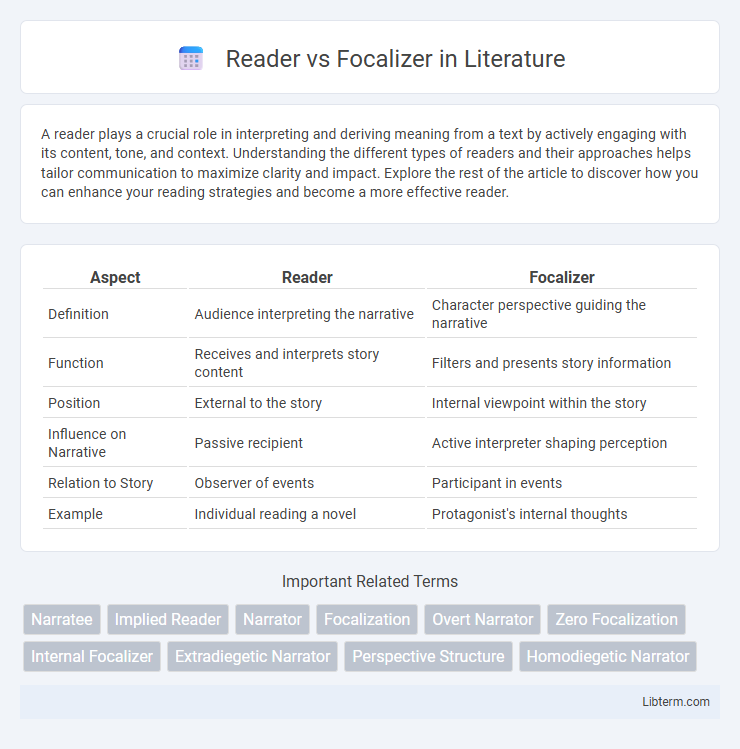A reader plays a crucial role in interpreting and deriving meaning from a text by actively engaging with its content, tone, and context. Understanding the different types of readers and their approaches helps tailor communication to maximize clarity and impact. Explore the rest of the article to discover how you can enhance your reading strategies and become a more effective reader.
Table of Comparison
| Aspect | Reader | Focalizer |
|---|---|---|
| Definition | Audience interpreting the narrative | Character perspective guiding the narrative |
| Function | Receives and interprets story content | Filters and presents story information |
| Position | External to the story | Internal viewpoint within the story |
| Influence on Narrative | Passive recipient | Active interpreter shaping perception |
| Relation to Story | Observer of events | Participant in events |
| Example | Individual reading a novel | Protagonist's internal thoughts |
Understanding the Reader and the Focalizer
The reader engages with a narrative through interpretation and perspective, actively constructing meaning from the text. The focalizer serves as the narrative lens, filtering the story's events and emotions through a character's viewpoint or consciousness. Understanding the reader and the focalizer enhances comprehension of narrative techniques, emphasizing how stories are experienced and conveyed.
Theoretical Foundations: Narratology and Perspective
Reader and focalizer are key concepts in narratology that define narrative perspective and interpretation. The reader represents the external participant who constructs meaning from the text, while the focalizer is the internal viewpoint character whose perception shapes the narrative's presentation. Understanding the distinction between these roles clarifies how narratives manipulate focalization to guide readers' access to knowledge and emotional engagement.
Defining the Reader’s Role in Narrative
The reader functions as an active interpreter, constructing meaning through engagement with narrative cues and focalization techniques that guide perspective and information flow. Focalizers control the narrative's point of view, filtering experiences and knowledge to shape the reader's understanding and emotional response. Defining the reader's role involves recognizing how focalization mediates the reception of storyworld events, enabling a co-creative process between text and audience.
Focalization: Types and Functions
Focalization in narrative theory refers to the perspective through which a story is perceived, shaping the reader's understanding and emotional engagement. It can be categorized into internal, external, and zero focalization, each defining different levels of access to characters' thoughts and feelings or external events. These types function to control information flow, influence narrative reliability, and shape the reader's immersion by aligning or distancing them from the narrative consciousness.
Reader vs Focalizer: Key Distinctions
Reader and focalizer represent two distinct narrative perspectives in literary analysis. The reader is the external audience who interprets the text, while the focalizer is the character or consciousness through whose perspective the narrative is experienced. Key distinctions lie in the reader's role as an observer versus the focalizer's role as an internal viewpoint shaping the perception of events and emotions within the story.
The Impact of Focalization on Interpretation
Focalization shapes interpretation by controlling the perspective through which events and characters are perceived, influencing the reader's emotional and cognitive engagement with the narrative. When a focalizer limits information to their own knowledge and bias, the audience receives a filtered reality that can alter meaning and affect narrative reliability. This selective viewpoint creates layers of subjectivity that challenge readers to discern truth, enhancing interpretive depth and complexity.
Reader Engagement and Narrative Immersion
The distinction between reader and focalizer significantly impacts reader engagement by shaping narrative immersion; the focalizer's perspective aligns the reader's access to information and emotional experience directly with a character's internal viewpoint. This alignment deepens immersion by limiting knowledge to what the focalizer perceives, fostering a more intimate connection between reader and narrative. Consequently, the dynamic interplay between reader and focalizer controls narrative transparency, enhancing the psychological complexity and engagement within literary texts.
Shifts in Focalization: Effects on the Reader
Shifts in focalization disrupt the reader's alignment with a narrative perspective, creating varying degrees of intimacy or distance from characters' experiences. This technique heightens cognitive engagement by prompting readers to reinterpret events through multiple viewpoints, enriching the narrative's complexity. By manipulating focalizers, authors influence emotional responses and guide readers' interpretive processes in subtle, nuanced ways.
Case Studies: Applying Reader and Focalizer Concepts
Case studies applying reader and focalizer concepts reveal distinct narrative perspectives that influence audience interpretation and emotional engagement. By analyzing focalizers, researchers identify the characters' subjective viewpoints and how these shape story events, whereas reader-based studies highlight how individual readers construct meaning through their unique contexts. These approaches collectively enhance understanding of narrative dynamics in diverse literary and media texts.
Conclusion: Implications for Literary Analysis
Reader and focalizer represent distinct narrative perspectives shaping literary interpretation; the reader actively constructs meaning, while the focalizer controls the flow of information within the text. Understanding their differences enhances literary analysis by revealing how narratives manipulate knowledge, bias, and empathy through focalization strategies. This distinction allows critics to explore the interaction between narrative structure and reader engagement, deepening insights into character development and thematic complexity.
Reader Infographic

 libterm.com
libterm.com